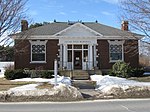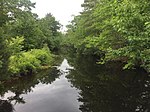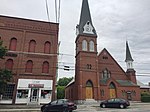Barnstead, New Hampshire
1767 establishments in New HampshireBarnstead, New HampshireTowns in Belknap County, New HampshireTowns in New HampshireUse mdy dates from July 2023

Barnstead is a town in Belknap County, New Hampshire, United States. The population was 4,915 at the 2020 census, up from 4,593 at the 2010 census. Home to the Suncook Lakes, Barnstead includes the villages of Center Barnstead, Barnstead Parade (identified as "Barnstead" on topographic maps) and South Barnstead.
Excerpt from the Wikipedia article Barnstead, New Hampshire (License: CC BY-SA 3.0, Authors, Images).Barnstead, New Hampshire
South Barnstead Road,
Geographical coordinates (GPS) Address Nearby Places Show on map
Geographical coordinates (GPS)
| Latitude | Longitude |
|---|---|
| N 43.340555555556 ° | E -71.260833333333 ° |
Address
White Buffalo Trading Post
South Barnstead Road
03218
New Hampshire, United States
Open on Google Maps










